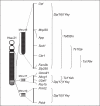Mouse models for Down syndrome-associated developmental cognitive disabilities
- PMID: 21865664
- PMCID: PMC3254039
- DOI: 10.1159/000329422
Mouse models for Down syndrome-associated developmental cognitive disabilities
Abstract
Down syndrome (DS) is mainly caused by the presence of an extra copy of human chromosome 21 (Hsa21) and is a leading genetic cause for developmental cognitive disabilities in humans. The mouse is a premier model organism for DS because the regions on Hsa21 are syntenically conserved with three regions in the mouse genome, which are located on mouse chromosome 10 (Mmu10), Mmu16 and Mmu17. With the advance of chromosomal manipulation technologies, new mouse mutants have been generated to mimic DS at both the genotypic and phenotypic levels. Further mouse-based molecular genetic studies in the future may lead to the unraveling of the mechanisms underlying DS-associated developmental cognitive disabilities, which would lay the groundwork for developing effective treatments for this phenotypic manifestation. In this review, we will discuss recent progress and future challenges in modeling DS-associated developmental cognitive disability in mice with an emphasis on hippocampus-related phenotypes.
Copyright © 2011 S. Karger AG, Basel.
Figures




Similar articles
-
Human chromosome 21 orthologous region on mouse chromosome 17 is a major determinant of Down syndrome-related developmental cognitive deficits.Hum Mol Genet. 2014 Feb 1;23(3):578-89. doi: 10.1093/hmg/ddt446. Epub 2013 Sep 16. Hum Mol Genet. 2014. PMID: 24041763 Free PMC article.
-
Mouse models of cognitive disabilities in trisomy 21 (Down syndrome).Am J Med Genet C Semin Med Genet. 2010 Nov 15;154C(4):400-16. doi: 10.1002/ajmg.c.30280. Am J Med Genet C Semin Med Genet. 2010. PMID: 20981769 Review.
-
A mouse model of Down syndrome trisomic for all human chromosome 21 syntenic regions.Hum Mol Genet. 2010 Jul 15;19(14):2780-91. doi: 10.1093/hmg/ddq179. Epub 2010 May 4. Hum Mol Genet. 2010. PMID: 20442137 Free PMC article.
-
Mouse models of Down syndrome as a tool to unravel the causes of mental disabilities.Neural Plast. 2012;2012:584071. doi: 10.1155/2012/584071. Epub 2012 May 22. Neural Plast. 2012. PMID: 22685678 Free PMC article. Review.
-
Mouse models of cognitive disorders in trisomy 21: a review.Behav Genet. 2006 May;36(3):387-404. doi: 10.1007/s10519-006-9056-9. Epub 2006 Mar 8. Behav Genet. 2006. PMID: 16523244 Review.
Cited by
-
GABAA receptor subtypes: Therapeutic potential in Down syndrome, affective disorders, schizophrenia, and autism.Annu Rev Pharmacol Toxicol. 2014;54:483-507. doi: 10.1146/annurev-pharmtox-011613-135947. Epub 2013 Oct 23. Annu Rev Pharmacol Toxicol. 2014. PMID: 24160694 Free PMC article. Review.
-
Overexpression of Chromosome 21 miRNAs May Affect Mitochondrial Function in the Hearts of Down Syndrome Fetuses.Int J Genomics. 2017;2017:8737649. doi: 10.1155/2017/8737649. Epub 2017 Sep 5. Int J Genomics. 2017. PMID: 29057256 Free PMC article.
-
The Adult Ts65Dn Mouse Model of Down Syndrome Shows Altered Swallow Function.Front Neurosci. 2019 Aug 29;13:906. doi: 10.3389/fnins.2019.00906. eCollection 2019. Front Neurosci. 2019. PMID: 31555077 Free PMC article.
-
Engineered chromosome-based genetic mapping establishes a 3.7 Mb critical genomic region for Down syndrome-associated heart defects in mice.Hum Genet. 2014 Jun;133(6):743-53. doi: 10.1007/s00439-013-1407-z. Epub 2013 Dec 22. Hum Genet. 2014. PMID: 24362460 Free PMC article.
-
GIRK2 Channels in Down Syndrome and Alzheimer's Disease.Curr Alzheimer Res. 2022;19(12):819-829. doi: 10.2174/1567205020666221223122110. Curr Alzheimer Res. 2022. PMID: 36567290
References
-
- Ahn KJ, Jeong HK, Choi HS, Ryoo SR, Kim YJ, Goo JS, Choi SY, Han JS, Ha I, Song WJ. DYRK1A BAC transgenic mice show altered synaptic plasticity with learning and memory defects. Neurobiol Dis. 2006;22:463–472. - PubMed
-
- Akeson EC, Lambert JP, Narayanswami S, Gardiner K, Bechtel LJ, Davisson MT. Ts65Dn – localization of the translocation breakpoint and trisomic gene content in a mouse model for Down syndrome. Cytogenet Cell Genet. 2001;93:270–276. - PubMed
-
- Altshuler DM, Gibbs RA, Peltonen L, Dermitzakis E, Schaffner SF, Yu F, Bonnen PE, de Bakker PI, Deloukas P, Gabriel SB, Gwilliam R, Hunt S, Inouye M, Jia X, Palotie A, Parkin M, Whittaker P, Chang K, Hawes A, Lewis LR, Ren Y, Wheeler D, Muzny DM, Barnes C, Darvishi K, Hurles M, Korn JM, Kristiansson K, Lee C, McCarrol SA, Nemesh J, Keinan A, Montgomery SB, Pollack S, Price AL, Soranzo N, Gonzaga-Jauregui C, Anttila V, Brodeur W, Daly MJ, Leslie S, McVean G, Moutsianas L, Nguyen H, Zhang Q, Ghori MJ, McGinnis R, McLaren W, Takeuchi F, Grossman SR, Shlyakhter I, Hostetter EB, Sabeti PC, Adebamowo CA, Foster MW, Gordon DR, Licinio J, Manca MC, Marshall PA, Matsuda I, Ngare D, Wang VO, Reddy D, Rotimi CN, Royal CD, Sharp RR, Zeng C, Brooks LD, McEwen JE. Integrating common and rare genetic variation in diverse human populations. Nature. 2010;467:52–58. - PMC - PubMed
-
- Andrle M, Fiedler W, Rett A, Ambros P, Schweizer D. A case of trisomy 22 in Pongo pygmaeus. Cytogenet Cell Genet. 1979;24:1–6. - PubMed
Publication types
MeSH terms
Grants and funding
LinkOut - more resources
Full Text Sources
Other Literature Sources
Medical

